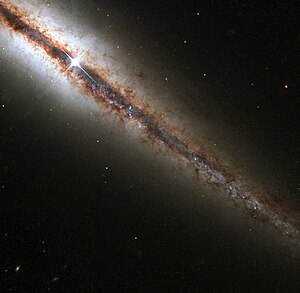NGC 4013
| Galaxy NGC 4013 |
|
|---|---|

|
|
| Galaxy NGC 4013 as seen by the Hubble Space Telescope ; the light source near the center is a foreground star. | |
| AladinLite | |
| Constellation | Big Bear |
|
Position equinox : J2000.0 , epoch : J2000.0 |
|
| Right ascension | 11 h 58 m 31.380 s |
| declination | + 43 ° 56 ′ 47.70 ″ |
| Appearance | |
| Morphological type | SAb / HII / LINER |
| Brightness (visual) | 11.5 likes |
| Brightness (B-band) | 12.3 mag |
| Angular expansion | 5.20 ′ × 1.0 ′ |
| Position angle | 66 ° |
| Surface brightness | 13.1 mag / arcmin² |
| Physical data | |
| Affiliation | Ursa Major Galaxy Cloud |
| Redshift | 0.002773 ± 0.000002 |
| Radial velocity | 831 ± 1 km / s |
|
Stroke distance v rad / H 0 |
(39 ± 3) x 10 6 ly (12.0 ± 0.8) Mpc |
| diameter | 100,000 ly |
| history | |
| discovery | Wilhelm Herschel |
| Discovery date | February 6, 1788 |
| Catalog names | |
| NGC 4013 • UGC 6963 • PGC 37691 • CGCG 215-010 • MCG + 07-25-009 • IRAS 11559 + 4413 • 2MASX J11583141 + 4356492 • GC 2652 • H II 733 • h 1041 • LDCE 867 NED056 • NSA 160829 • NVSS J115831 + 435651 | |
NGC 4013 is an active spiral galaxy of the Hubble type SAb with extensive star formation regions in the constellation Great Bear. It is an estimated 39 million light years from the Milky Way and about 60,000 light years across.
In December 1989 the supernova SN 1989Z was observed here.
The object was discovered on February 6, 1788 by the German-British astronomer Wilhelm Herschel .
Web links
Commons : NGC 4013 - collection of images, videos, and audio files
- Hubble Space Telescope
- NOAO
- astronomie.de
- GoBlack
- astronews.com: A galaxy from the March 1, 2001 page
- Aladin Lite
